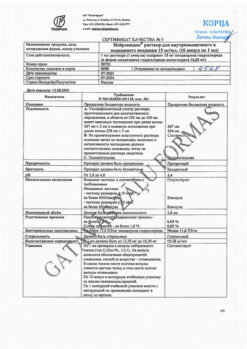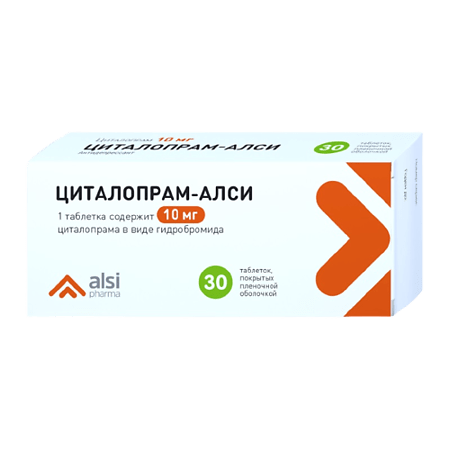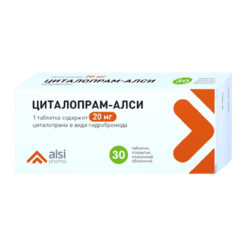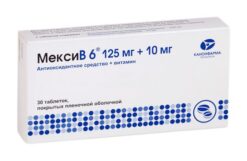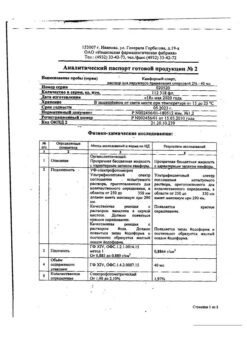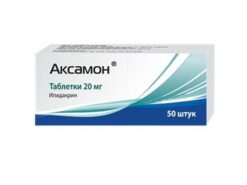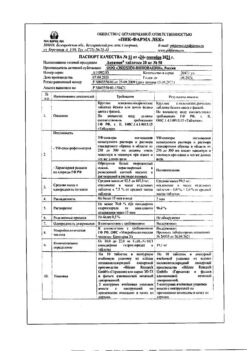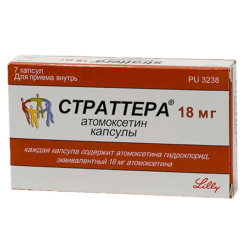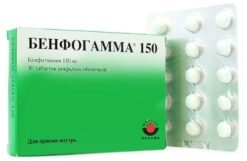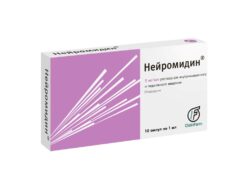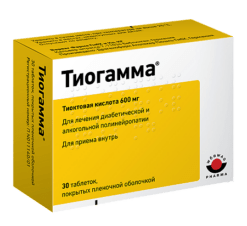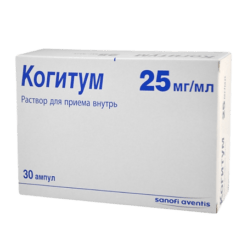Subtotal: €63.56
Citalopram-ALSI, 10 mg 30 pcs
€9.08 €7.94
Out of stock
(E-mail when Stock is available)
Pharmacotherapeutic group: Antidepressant.
ATX code: N06AB04.
Pharmacological properties
Citalopram is an antidepressant, a selective serotonin reuptake inhibitor (SSRI).
Pharmacodynamics:
Biochemical and behavioral studies have shown that citalopram is a potent serotonin reuptake inhibitor (5-HT).
The duration of citalopram treatment has no effect on 5-HT reuptake inhibition habituation. Tolerance to serotonin reuptake inhibition does not occur with long-term use of citalopram.
Citalopram is a superselective serotonin reuptake inhibitor (SSRI) with little or no effect on noradrenaline, dopamine and GABA.
Citalopram has no or very weak ability to bind to a number of receptors, including 5-HT1A-, 5-HT2-serotonin, D1– and D2-dopamine, α1-, α2- and
β-adrenergic, H1-histamine, muscarinic cholinoreceptors, benzodiazepine and opioid receptors.
The major metabolites of citalopram are all SSRIs, although their activity-selectivity ratios are lower than those of citalopram. However, the selectivity ratios of these metabolites are higher than those of many next-generation SSRIs. The metabolites are not involved in the overall antidepressant effect.
While citalopram does not bind to opioid receptors, it potentiates the antinociceptive effects of commonly used opioid analgesics.
In humans, citalopram does not impair cognitive or psychomotor function and has virtually no sedative properties, even in combination with alcohol.
In a double-blind, placebo-controlled ECG study in healthy volunteers, the change in QTc (Friedericia formula correction) from baseline was 7.5 (90% confidence interval 5.9-9.1) ms for the
20 mg/day dose and 16.7 (90% confidence interval 15.0-18.4) ms for the 60 mg/day dose.
Pharmacokinetics:
Absorption
The absorption of the drug is almost complete and independent of food intake (mean time to reach maximum plasma concentration (Tmax) about 3 hours). Bioavailability when taken orally is approximately 80%.
Distribution
The apparent volume of distribution (Vd)β is approximately 12-17 l/kg. The binding of citalopram and its major metabolites to plasma proteins is less than 80%.
Biotransformation
Citalopram is metabolized to active metabolites: demethylcitalopram, didemethylcitalopram, citalopram-N-oxide and an inactive derivative of deaminated propionic acid. All of the active metabolites are also SSRIs, although their effects are weaker than those of the parent compound. The predominant component in plasma is unchanged citalopram. The concentrations of demethylcitalopram and didemethylcitalopram are typically 30-50% and 5-10% of the citalopram concentration, respectively. The biotransformation of citalopram to demethylcitalopram is mediated by CYP2C19 (approximately 38%), CYP3A4 (approximately 31%) and CYP2D6 (approximately 31%) isoenzymes.
Evolution
The half-life (T1/2) is approximately 11/2 days. The systemic plasma clearance (Cls) of citalopram is approximately 0.3-0.4 L/min, and the oral clearance (Cloral) is approximately 0.4 L/min.
Citalopram is excreted primarily through the liver (85%) and the kidneys (15%); 12-23% of the daily dose is excreted in the urine as unchanged citalopram. Hepatic (residual) clearance is approximately 0.3 L/min, and renal clearance is approximately 0.05-0.08 L/min.
Linearity
The kinetics of citalopram are linear. Equilibrium plasma concentration is reached within 1-2 weeks. The average equilibrium concentration is about 300 nmol/L (165-405 nmol/L) at a daily dose of 40 mg.
Elderly patients (> 65 years)
The elderly patients have been shown to have a longer half-life of the drug (1.5-3.75 days) and lower clearance rates (0.08-0.3 L/min) due to lower metabolic rate. The equilibrium concentration is approximately twice as high in elderly patients than in younger patients receiving the same dose.
Disordered liver function
Citalopram is more slowly excreted in patients with impaired liver function. The half-life of citalopram is about twice as long and the equilibrium concentration is about twice as high compared to patients with normal liver function at the same dose.
Decreased renal function
Citalopram is more slowly excreted in patients with mild to moderate impaired renal function, which, however, does not significantly affect the pharmacokinetics of citalopram. There is currently no information regarding the treatment of patients with severe renal impairment (creatinine clearance < 30 ml/min).
Polymorphism
Studies in vivo
Indications
Moderate to severe depressive episodes and preventing their relapse. Panic disorder with/without agoraphobia.
Pharmacological effect
Pharmacotherapeutic group: Antidepressant.
ATX code: N06AB04.
Pharmacological properties
Citalopram is an antidepressant, selective serotonin reuptake inhibitor (SSRI).
Pharmacodynamics:
Biochemical and behavioral studies have shown that citalopram is a potent serotonin (5-HT) reuptake inhibitor.
Duration of treatment with citalopram does not affect tolerance to 5-HT uptake inhibition. With long-term use of citalopram, tolerance to the suppression of serotonin reuptake does not occur.
Citalopram is a superselective serotonin reuptake inhibitor (SSRI) with no or minimal effect on the uptake of norepinephrine, dopamine and gamma-aminobutyric acid.
Citalopram has no or very weak ability to bind to a number of receptors, including 5-HT1A-, 5-HT2-serotonin, D1- and D2-dopamine, α1-, α2- and
β-adrenergic, H1-histamine, muscarinic cholinergic receptors, benzodiazepine and opioid receptors.
All major metabolites of citalopram are SSRIs, although their potency and selectivity ratios are lower than those of citalopram. However, the selectivity ratios of these metabolites are higher than those of many newer generation SSRIs. Metabolites are not involved in the formation of the general antidepressant effect.
Although citalopram does not bind to opioid receptors, it potentiates the antinociceptive effect of commonly used opioid analgesics.
In humans, citalopram does not impair cognitive and psychomotor functions and has virtually no sedative properties, even in combination with alcohol.
In a double-blind, placebo-controlled ECG study in healthy volunteers, the change in QTc (Fridericia’s formula) from baseline was 7.5 (90% confidence interval 5.9-9.1) ms per dose
20 mg/day and 16.7 (90% confidence interval 15.0-18.4) ms for a dose of 60 mg/day.
Pharmacokinetics:
Absorption
Absorption of the drug is almost complete and does not depend on food intake (the average time to reach maximum plasma concentration (Tmax) is about 3 hours). Bioavailability when taken orally is approximately 80%.
Distribution
The apparent volume of distribution (Vd)β is approximately 12-17 l/kg. The binding of citalopram and its main metabolites to plasma proteins is less than 80%.
Biotransformation
Citalopram is metabolized to the active metabolites: demethylcitalopram, didemethylcitalopram, citalopram-N-oxide and the inactive deaminated propionic acid derivative. All active metabolites are also SSRIs, although their effect is weaker than that of the parent compound. The predominant component in the blood plasma is unchanged citalopram. The concentration of demethylcitalopram and didemethylcitalopram is usually 30-50% and 5-10% of the concentration of citalopram, respectively. The biotransformation of citalopram to demethylcitalopram is mediated by the isoenzymes CYP2C19 (approximately 38%), CYP3A4 (approximately 31%), and CYP2D6 (approximately 31%).
Removal
The half-life (T1/2) is approximately 11/2 days. The systemic plasma clearance (Cls) of citalopram is approximately 0.3-0.4 L/min, and the oral clearance (Cloral) is approximately 0.4 L/min.
Citalopram is excreted mainly through the liver (85%) and through the kidneys (15%); 12-23% of the daily dose is excreted in the urine as unchanged citalopram. Hepatic (residual) clearance is approximately 0.3 L/min, and renal clearance is approximately 0.05-0.08 L/min.
Linearity
The kinetics of citalopram is linear. Equilibrium plasma concentrations are achieved within 1-2 weeks. The average steady-state concentration is about 300 nmol/l (165-405 nmol/l) against a daily dose of 40 mg.
Elderly patients (>65 years)
It has been shown that in elderly patients, due to a decrease in the metabolic rate, there is a longer half-life of the drug (1.5-3.75 days) and lower clearance rates (0.08-0.3 l/min). Steady-state concentrations are approximately twice as high in elderly than in younger patients receiving the same dose.
Decreased liver function
Citalopram is eliminated more slowly in patients with impaired liver function. The half-life of citalopram is approximately twice as long and the steady-state concentration is approximately twice as high compared to patients with normal liver function when taking the same dose.
Decreased kidney function
Citalopram is eliminated more slowly in patients with mild or moderate renal impairment, which, however, does not have a significant effect on the pharmacokinetics of citalopram. There is currently no information regarding the treatment of patients with severe renal impairment (creatinine clearance <30 ml/min).
Polymorphism
In vivo studies have shown that the metabolism of citalopram is not characterized by a clinically significant sparteine/debrisoquine oxidation polymorphism (CYP2D6). In patients with weak CYP2C19 isoenzyme activity, as a precautionary measure, the recommended initial dose should not exceed 10 mg per day.
Special instructions
Use in children and adolescents under 18 years of age
Antidepressants should not be prescribed to children and adolescents under 18 years of age. In clinical studies, children and adolescents taking antidepressants were more likely to experience suicidal behavior (suicide attempts and suicidal ideation) and hostility (with a predominance of aggressive behavior, confrontational behavior, and irritation) than those in the placebo group.
When using drugs belonging to the SSRI therapeutic group, including citalopram, the following should be considered.
Paradoxical anxiety
Some patients with panic disorder may experience increased anxiety when starting antidepressant therapy. This paradoxical reaction usually resolves within the first two weeks after starting treatment. To reduce the likelihood of anxiogenic effects, low initial doses are recommended.
Hyponatremia
Rare cases of hyponatremia, apparently due to inadequate secretion of antidiuretic hormone (ADH), have been reported with the use of SSRIs. This reaction was generally reversible if treatment with the drug was discontinued. The risk was higher in older women.
Suicide/suicidal ideation or clinical worsening
Depression is associated with an increased risk of suicidal ideation, self-harm and suicide (suicidal events). This risk persists until stable remission develops.
Since improvement may not be observed during the first few weeks of treatment or even a longer period of time, patients should be closely monitored to ensure that such improvement is detected in a timely manner. Clinical experience suggests that the risk of suicide increases in the early stages of recovery.
Other psychiatric disorders for which citalopram is prescribed may also be associated with an increased risk of suicidal events. In addition, these conditions may be a comorbidity in relation to a depressive episode. When treating patients with other mental disorders, the same precautions should be taken as when treating patients with a depressive episode.
Patients with a history of suicidal tendencies or patients with a significant level of suicidal thoughts before treatment are at greater risk for suicidal ideation or suicide attempts and should be closely monitored during treatment. A meta-analysis of placebo-controlled clinical trials of antidepressants in adult patients with mental disorders found that there is an increased risk of suicidal behavior in patients under 25 years of age when taking antidepressants compared with placebo. Drug treatment of these patients, and in particular those at high risk for suicide, should be accompanied by careful monitoring, especially early in treatment and during dose changes. Patients (and caregivers) should be warned to monitor for any signs of clinical worsening, suicidal behavior or ideation, or unusual changes in behavior, and to seek immediate medical advice if these symptoms occur.
Akathisia/psychomotor restlessness
The use of drugs from the SSRI/SNRI group is associated with the development of akathisia, characterized by a feeling of subjectively unpleasant or unbearable motor restlessness, restlessness and the need to move. Often patients in this condition cannot sit or stand quietly. Most often this condition occurs during the first weeks of treatment. In patients with such symptoms, increasing the dose may cause a sharp deterioration of the condition.
Mania
Patients with bipolar affective disorder may develop a manic phase. If a manic state develops, citalopram should be discontinued.
Seizures
There is a risk of seizures when taking antidepressants. In any patient who experiences a seizure, citalopram should be discontinued. Citalopram should not be used in patients with unstable epilepsy; Controlled seizures require careful monitoring. If the frequency of seizures increases, citalopram should be discontinued.
Diabetes mellitus
In patients with diabetes, the use of SSRIs may change the concentration of glucose in the blood. In this case, dose adjustment of insulin and/or oral hypoglycemic drugs may be required.
Serotonin syndrome
In rare cases, the development of serotonin syndrome has been reported when taking SSRIs. The development of this condition may be indicated by a combination of symptoms such as agitation, myoclonus and hyperthermia. If such phenomena occur, citalopram should be immediately discontinued and symptomatic treatment should be started.
Serotonergic drugs
Citalopram should not be used in combination with drugs that have serotonergic effects, such as sumatriptan or other triptans, tramadol, oxytriptan and tryptophan.
Bleeding
There are reports of the development of skin hemorrhages, such as ecchymosis, gynecological, gastrointestinal bleeding and other hemorrhagic complications of the skin or mucous membranes while taking SSRIs. Caution should be exercised when using SSRIs concomitantly with drugs that affect platelet function or drugs that may increase the risk of bleeding, as well as when treating patients with a history of bleeding disorders.
Electroconvulsive therapy (ECT)
Because clinical experience with the concomitant use of SSRIs and electroconvulsive therapy (ECT) is limited, caution should be used when citalopram and ECT are used concomitantly.
Reversible selective MAO A inhibitors
Concomitant use of citalopram and MAO A inhibitors is not recommended due to the risk of developing serotonin syndrome.
St. John’s wort
Citalopram and preparations containing St. John’s wort (Hypericum perforatum) should not be used simultaneously, because this may increase the risk of adverse reactions.
Psychosis
Treatment of psychotic patients with a depressive episode may increase the manifestation of psychotic symptoms.
Withdrawal symptoms when stopping SSRI therapy
Withdrawal symptoms occur quite often, especially when therapy is abruptly stopped.
The likelihood of withdrawal symptoms may depend on a number of factors, including the duration of treatment, the dose of the drug, and the rate at which it is tapered.
The most commonly reported symptoms were dizziness, sensory disturbances (including paresthesia), sleep disturbances (including insomnia and vivid dreams), agitation or anxiety, nausea and/or vomiting, tremor, confusion, sweating, headache, diarrhea, rapid heartbeat, emotional lability, irritability and visual disturbances. These symptoms are usually mild or moderate in severity, but may be severe in some patients.
Typically, such manifestations develop during the first days after discontinuation of the drug, however, there are isolated reports of the development of such conditions in patients who accidentally missed taking the next dose.
In most cases, these complications resolve within 2 weeks, although in some patients symptoms may persist for 2-3 months or longer. Therefore, before completing the course of taking citalopram, it is recommended to gradually reduce the dose of the drug over a period of several weeks to several months, depending on the patient’s condition (see section “Method of administration and dosage”).
QT prolongation
Citalopram has been found to cause dose-dependent prolongation of the QT interval. Cases of QT prolongation and ventricular arrhythmias, including torsade de pointes, have been reported post-marketing, predominantly in female patients with hypokalemia or pre-existing QT prolongation or other cardiac disease.
The drug is recommended to be used with caution in patients with significant bradycardia, in patients who have recently suffered a myocardial infarction, or with decompensated heart failure.
Electrolyte disturbances, such as hypokalemia and hypomagnesemia, increase the risk of malignant arrhythmias and should therefore be corrected before initiating citalopram therapy.
In patients with compensated heart disease, an ECG study should be performed before starting treatment.
If any signs of cardiac arrhythmias occur during treatment with citalopram, the latter should be discontinued and an ECG study performed.
Impact on the ability to drive vehicles and machinery
Citalopram has a minimal or moderate ability to affect the ability to drive vehicles and operate machinery.
Psychoactive drugs can affect decision making and the ability to respond to emergencies. Patients should be warned about the potential effect on the ability to drive vehicles and operate machines.
Active ingredient
Citalopram
Composition
One film-coated tablet contains:
Active ingredient:
citalopram hydrobromide 12.5 mg, 25.0 mg and 50.0 mg, corresponding to citalopram 10 mg, 20 mg and 40 mg;
Excipients: microcrystalline cellulose 46.90/93.80/187.60 mg, pregelatinized starch 20.20/40.40/80.80 mg, magnesium stearate 0.40/0.80/1.60 mg, Opadry II [polyvinyl alcohol (1.28/2.56/5.12) mg, titanium dioxide (0.80/1.60/3.20) mg, macrogol (polyethylene glycol) (0.65/1.30/2.60) mg, talc (0.47/0.94/1.88) mg] 3.20 mg/6.40 mg/12.80 mg.
Pregnancy
Published data on pregnant women (more than 2500 completed cases) did not show the formation of any malformations and feto-/neonatal toxicity under the influence of citalopram. However, citalopram should not be used during pregnancy unless absolutely necessary and a careful assessment of the potential risks and benefits.
If citalopram use is continued late in pregnancy, especially in the third trimester, neonates should be monitored. Abrupt withdrawal of the drug during pregnancy should be avoided.
If the mother takes SSRIs/SNRIs in late pregnancy, newborns may experience the following symptoms: respiratory distress, cyanosis, apnea, seizures, instability of body temperature, feeding difficulties, vomiting, hypoglycemia, muscle hypertension, muscle hypotonia, hyperreflexia, tremor, increased neuro-reflex excitability, irritability, lethargy, constant crying, drowsiness and restless sleep. These symptoms may occur due to the development of withdrawal syndrome or serotonergic effects. In most cases, complications develop immediately after or shortly (< 24 hours) after birth.
Epidemiological data suggest that use of SSRIs during pregnancy, especially later in pregnancy, may increase the risk of developing persistent pulmonary hypertension in the newborn. The observed risk was approximately
5 cases per 1000 pregnancies. In the general population, the risk of this disorder is 1-2 per 1000 pregnancies.
Citalopram passes into breast milk. It is estimated that infants receive approximately 5% of the maternal daily dose of citalopram, calculated by weight (in mg/kg). Virtually no consequences were observed for children. However, the available information is insufficient to assess the risks to the child. Therefore, breastfeeding is not recommended during treatment with citalopram.
Fertility
Data from animal studies have shown that citalopram may affect sperm quality. Reports of some SSRIs in humans have shown that the effects on sperm quality are reversible. So far, no effect of citalopram on human fertility has been observed.
Contraindications
Hypersensitivity to citalopram or any of the excipients.
Simultaneous use with monoamine oxidase inhibitors (MAO) (including selegiline at a dose above 10 mg/day). The time interval between stopping taking irreversible MAO inhibitors and starting citalopram should be at least 14 days. In the case of using reversible MAO A inhibitors, the duration of the break is determined in accordance with the instructions for medical use of these drugs. Treatment with MAO inhibitors can be started no earlier than 7 days after stopping citalopram.
Concomitant use with linezolid, if it is impossible to closely monitor the patient and monitor blood pressure.
Concomitant use with pimozide.
Established prolongation of the QT interval or congenital long QT interval.
Concomitant use with drugs that prolong the QT interval.
Children and adolescents (up to 18 years) (efficacy and safety of use have not been confirmed).
With caution
History of QT prolongation; ventricular arrhythmia, including torsade de pointes; significant bradycardia; recent acute myocardial infarction; decompensated heart failure; hypokalemia and/or hypomagnesemia (electrolyte imbalances should be corrected before starting treatment with citalopram); severe renal failure (creatinine clearance lower
30 ml/min); severe liver failure (careful dose selection is recommended); severe suicidal behavior (careful monitoring of patients is required until the condition improves several weeks after the start of treatment); diabetes mellitus (dosage adjustment of insulin and/or oral hypoglycemic drugs may be required); tendency to bleeding (especially when used simultaneously with drugs that affect platelet function or drugs that may increase the risk of bleeding); simultaneous use with the MAO B inhibitor selegiline, serotonergic drugs; drugs that lower the seizure threshold; cimetidine (increased equilibrium concentration of citalopram), metoprolol (increased concentration of metoprolol), lithium and tryptophan (increased effect), drugs containing St. John’s wort (increased side effects); oral anticoagulants and medications that affect blood clotting (increasing the risk of bleeding); drugs that are weak metabolites of the CYP2C19 isoenzyme (it is necessary to reduce the initial dose); ethanol; electroconvulsive therapy; elderly people over 65 years of age (dose reduction required); pregnancy, breastfeeding period.
More detailed information about the instructions and precautions is provided in the sections “Interaction with other drugs”, “Special instructions”, “Use during pregnancy and breastfeeding”.
Side Effects
Undesirable effects observed when taking the drug Citalopram-ALSI are usually mild and transient in nature. They most often occur in the first or second week of treatment and usually subside significantly as therapy continues.
For the following reactions, a dependence on the dose used was found: increased sweating, dry mouth, insomnia, drowsiness, diarrhea, nausea and weakness.
Below are data on the incidence of adverse reactions associated with SSRIs and/or citalopram, observed in ≥ 1% of patients participating in double-blind, placebo-controlled studies and during the post-marketing period. Frequencies are listed as follows: very common (≥1/10), common (≥1/100 to <1/10), uncommon (≥1/1000 to <1/100), rare (≥1/10,000 to <1/1000), very rare (<1/10,000), unknown (cannot be estimated from existing data).
From the blood and lymphatic system: unknown – thrombocytopenia.
From the immune system: unknown – hypersensitivity, anaphylactic reactions.
From the endocrine system: unknown – insufficient secretion of antidiuretic hormone (ADH).
Metabolic and nutritional disorders: often – loss of appetite, weight loss; infrequently – increased appetite, weight gain; rarely – hyponatremia; unknown – hypokalemia.
From the mental side: often – agitation, decreased libido, anxiety, nervousness, confusion, anorgasmia (in women), unusual dreams; infrequently – aggression, depersonalization, hallucinations, mania; unknown – panic attacks, bruxism, anxiety, suicidal thoughts, suicidal behavior. Cases of suicidal thoughts and behavior have been reported during treatment with citalopram and immediately after discontinuation of treatment.
From the nervous system: very often – drowsiness, insomnia; often – tremor, paresthesia, dizziness, impaired attention; infrequently – fainting; rarely – grand mal seizures, dyskinesia, taste disturbances; unknown – seizure disorders, serotonin syndrome, extrapyramidal disorders, akathisia, movement disorders.
From the organs of vision: infrequently – mydriasis (dilation of the pupils); unknown – visual impairment.
From the organ of hearing and labyrinthine disorders: often – tinnitus.
From the cardiovascular system: very often – palpitations; uncommon – bradycardia, tachycardia; rarely – bleeding; unknown – prolongation of the QT interval on the electrocardiogram, ventricular arrhythmia, including torsade de pointes, orthostatic hypotension.
From the respiratory system, chest and mediastinal organs: often – yawning; unknown – nosebleed.
From the gastrointestinal tract: very often – dry mouth, nausea; often – diarrhea, vomiting, constipation; unknown – gastrointestinal bleeding (including rectal bleeding).
From the liver and biliary tract: rarely – hepatitis; unknown – abnormal liver function parameters.
From the skin and subcutaneous tissues: very often – increased sweating; often – itching; uncommon – urticaria, alopecia, rash, purpura, photosensitivity; unknown – ecchymosis, angioedema.
From the musculoskeletal and connective tissue side: often – myalgia, arthralgia.
From the kidneys and urinary tract: unknown – urinary retention.
From the reproductive system and mammary glands: often – impotence, impaired ejaculation, lack of ejaculation; infrequently – menorrhagia (in women); unknown – galactorrhea, metrorrhagia (uterine bleeding), priapism (in men).
From the body as a whole and disorders at the injection site: often – weakness; infrequently – swelling; rarely – hyperthermia.
Epidemiological studies predominantly involving patients aged
50 years and older have shown that there is an increased risk of bone fractures in patients taking SSRIs and tricyclic antidepressants. The mechanism leading to this risk is unknown.
Cases of QT prolongation and ventricular arrhythmias, including torsades de pointes, have been reported post-marketing, predominantly in female patients with hypokalemia or with pre-existing QT prolongation and other cardiac disease.
Withdrawal from citalopram (especially abruptly) often results in withdrawal symptoms. The most common symptoms include dizziness, sensory disorders (including paresthesia), sleep disorders (including insomnia and intense dreams), agitation or anxiety, nausea and/or vomiting, tremors, confusion, sweating, headache, diarrhea, palpitations, emotional instability, irritability, and visual disturbances. As a rule, these effects are mild or moderate and disappear quickly, however, in some patients they may occur in a more acute form and/or for a longer period of time. If citalopram therapy is no longer required, it is recommended to gradually discontinue the drug by reducing its dose.
Interaction
Pharmacodynamic interaction
Cases of the development of serotonin syndrome have been described with the combined use of citalopram with moclobemide and buspirone.
Contraindicated combinations
MAO inhibitors
Concomitant use of citalopram and MAO inhibitors may lead to serious adverse effects, including serotonin syndrome.
Cases of serious and sometimes fatal reactions have been reported in patients receiving an SSRI and a monoamine oxidase inhibitor (MAOI) concomitantly, including the irreversible MAOI selegiline and the reversible MAOIs linezolid and moclobemide, as well as in patients who recently stopped taking an SSRI and started taking an MAOI.
In some of the presented cases, features resembling serotonin syndrome were noted.
Symptoms of interactions between citalopram and MAOIs included pyrexia, rigidity, myoclonus, autonomic instability with rapid fluctuations in vital signs, and mental status changes that included confusion, irritability, and excessive agitation progressing to delirium and coma.
Drugs that prolong the QT interval
Pharmacokinetic and pharmacodynamic studies of the interaction between citalopram and drugs that prolong the QT interval have not been conducted. The additive effect of citalopram and these drugs cannot be excluded. Thus, the simultaneous use of citalopram and drugs that prolong the QT interval, such as class IA and III antiarrhythmics, antipsychotics (for example, phenothiazine derivatives, pimozide, haloperidol), tricyclic antidepressants, some antimicrobials (for example, sparfloxacin, moxifloxacin, erythromycin IV, pentamidine, antimalarials, especially halofantrine), some antihistamines (astemizole, mizolastine), etc., are contraindicated.
Pimozide
In a study, a single 2 mg dose of pimozide to subjects taking racemic citalopram 40 mg/day for 11 days resulted in an increase in pimozide AUC and Cmax, although not always. Concomitant use of pimozide and citalopram resulted in a mean prolongation of the QTc interval by approximately 10 ms. Given the development of interaction with low doses of pimozide, simultaneous use of citalopram and pimozide is contraindicated.
Combinations requiring caution
Selegiline (selective MAO B inhibitor)
Pharmacokinetic and pharmacodynamic interaction studies with concomitant use of citalopram (20 mg/day) and selegiline (10 mg/day) (MAO B selective dose) did not reveal any clinically significant interactions. The simultaneous use of citalopram and selegiline (at a dose exceeding 10 mg per day) is not recommended.
Serotonergic drugs
Lithium and tryptophan
In clinical studies of the simultaneous use of lithium and citalopram, no pharmacodynamic interactions were identified. However, increased effects have been reported when SSRIs are coadministered with lithium or tryptophan, so the use of such combinations should be done with caution.
Blood lithium levels are monitored as usual.
Concomitant use with serotonergic drugs such as tramadol and sumatriptan may result in increased serotonergic effects. Until there is definitive data on possible interactions, the combination of citalopram with 5-HT receptor agonists such as sumatriptan and other triptans is not recommended.
St. John’s wort
The dynamic interaction of SSRIs with herbal preparations containing St. John’s wort (Hypericum perforatum) may lead to an increased incidence of adverse reactions. Pharmacokinetic interactions have not been studied.
Anticoagulants and agents affecting blood clotting
Caution should be exercised when prescribing citalopram to patients receiving anticoagulants, drugs that affect platelet function, such as non-steroidal anti-inflammatory drugs (NSAIDs), acetylsalicylic acid, dipyridamole and ticlopidine, or other drugs (for example, atypical antipsychotics, phenothiazines, tricyclic antidepressants) that may increase the risk of bleeding.
Electroconvulsive therapy (ECT)
There are no clinical trial data demonstrating the risks or benefits of concomitant use of ECT and citalopram.
Alcohol
No pharmacodynamic or pharmacokinetic interactions were observed between citalopram and alcohol. However, the combined use of citalopram and alcohol is not recommended.
Drugs that lower the seizure threshold
SSRIs may lower the seizure threshold. Caution is advised when used concomitantly with other drugs that may lower the seizure threshold (eg, antidepressants [tricyclics, SSRIs], antipsychotics [phenothiazines, thioxanthenes, and butyrophenones], mefloquine, bupropion, and tramadol).
Neuroleptics
Experience with citalopram has not revealed clinically significant interactions with antipsychotics. However, as with other SSRIs, the possibility of pharmacodynamic interactions cannot be excluded.
Pharmacokinetic interactions
The biotransformation of citalopram to demethylcitalopram is mediated by the isoenzymes of the cytochrome P450 system CYP2C19 (about 38%), CYP3A4 (about 31%) and CYP2D6 (about 31%). The fact that citalopram is metabolized by more than one isoenzyme suggests that inhibition of its biotransformation is unlikely, since the degree of inhibition of one of the enzymes can be compensated by others.
Therefore, the simultaneous administration of citalopram with other drugs has a very low probability of pharmacokinetic interactions.
Food
It has not been reported that food intake affects the absorption and other pharmacokinetic properties of citalopram.
Effect of other drugs on the pharmacokinetics of citalopram
When used together, ketoconazole (a strong inhibitor of the CYP3A4 isoenzyme) did not change the pharmacokinetics of citalopram.
Pharmacokinetic interaction studies between lithium and citalopram did not reveal any interactions.
Cimetidine (a strong inhibitor of CYP2D6, CYP3A4 and CYP1A2 isoenzymes) caused a moderate increase in the steady-state concentration of citalopram.
Caution is recommended when prescribing citalopram in combination with cimetidine. Dose adjustment may be required.
Effect of citalopram on the pharmacokinetics of other drugs
Pharmacokinetic/pharmacodynamic interaction studies of citalopram and metoprolol (a CYP2D6 isoenzyme substrate) showed a 2-fold increase in metoprolol concentrations, but no statistically significant increase in the effect of metoprolol on blood pressure and heart rate in healthy volunteers was noted. Caution must be exercised when using metoprolol and citalopram together. Dose adjustment may be required.
Citalopram and demethylcitalopram are minor inhibitors of CYP2C9, CYP2E1 and CYP3A4 and only weak inhibitors of CYP1A2, CYP2C19 and CYP2D6 compared to other SSRIs considered significant inhibitors.
Levomepromazine, digoxin, carbamazepine
No changes or only very small clinically significant changes were observed when citalopram was co-administered with substrates of CYP1A2 (clozapine and theophylline), CYP2C9 (warfarin), CYP2C19 (imipramine and mephenytoin), CYP2D6 (sparteine, imipramine, amitriptyline, risperidone) and CYP3A4 (warfarin, carbamazepine (and its metabolite). carbamazepine epoxide) and triazolam).
No pharmacokinetic interaction was observed between citalopram and levomepromazine or digoxin (indicating that citalopram does not induce or inhibit P-glycoprotein).
Desipramine, imipramine
Pharmacokinetic studies showed no changes in levels of either citalopram or imipramine, although levels of desipramine, the main metabolite of imipramine, were increased. With the simultaneous use of citalopram and desipramine, the level of the latter in the blood plasma was increased. A dose reduction of desipramine may be required.
Overdose
Clinical data on citalopram overdose are limited and in many cases are associated with concomitant overdose of other drugs or alcohol. Cases of fatal overdose of citalopram have been reported, however, most deaths were associated with concomitant overdose of other drugs.
Symptoms.
In case of overdose, the following symptoms were observed: convulsions, tachycardia, drowsiness, prolongation of the QT interval, coma, vomiting, tremor, hypotension, cardiac arrest, nausea, serotonin syndrome, agitation, bradycardia, dizziness, blockade of the His bundles, prolongation of the QRS complex, hypertension, mydriasis, pirouette-type arrhythmia, stupor, sweating, cyanosis, hyperventilation, as well as atrial and ventricular arrhythmias.
Treatment.
There is no specific antidote. Treatment is symptomatic and supportive. Gastric lavage should be performed and activated charcoal and osmotic laxatives (eg, sodium sulfate) given. If consciousness is impaired, the patient should be intubated. ECG and vital signs should be monitored.
ECG monitoring is recommended in case of overdose in patients with congestive heart failure/bradyarrhythmias, in patients receiving concomitant treatment with drugs that prolong the QT interval, or in patients with metabolic disorders such as liver failure.
Storage conditions
At a temperature not exceeding 25 ºС in the original packaging.
Keep out of the reach of children.
Shelf life
3 years. Do not use after the expiration date stated on the package.
Manufacturer
ALSI Pharma, Russia
| Shelf life | 3 years. Do not use after the expiration date stated on the package. |
|---|---|
| Conditions of storage | At a temperature not exceeding 25 ºC in the original package. Keep out of reach of children. |
| Manufacturer | ALSI Pharma, Russia |
| Medication form | pills |
| Brand | ALSI Pharma |
Other forms…
Related products
Buy Citalopram-ALSI, 10 mg 30 pcs with delivery to USA, UK, Europe and over 120 other countries.

